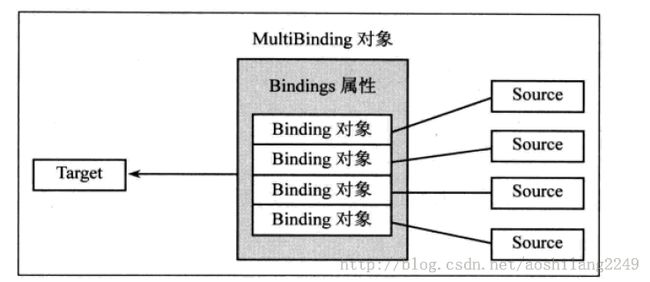WPF Data Binding之数据的转换和校验【四】
Binding的作用就是架在Source和Target之间的桥梁,数据可以在这座桥梁的帮助下来流通。就像现实社会中桥梁需要设置安检和关卡一样,Binding这座桥上也可以设置关卡对数据进行验证,不仅如此,如果Binding两端需要不同的数据类型的时候我们还可以为数据设置转换器。
Binding用于数据有效性校验的关卡是他的ValidationRules属性,用于数据类型转换的关卡是它的Convert属性。
1.1 Binding的数据校验
Binding的ValidationRules属性是Collection<ValidationRule>,从它的名称和数据类型我们可以得知可以为每个Binding设置多个数据校验条件,每一个条件是一个ValidationRule对象。ValidationRule是一个抽象类,在使用的时候我们需要创建它的派生类并实现它的Validate方法的返回值是ValidationResult类型对象,如果通过验证,就把ValidationResult对象的IsValidate属性设为true,反之,则需要将IsValidate设置为false并为其ErrorContent属性设置一个合适的消息内容(一般是字符串)。
下面这个程序的UI绘制一个TextBox和一个Slider,然后在后台C#代码中建立Binding把它们关联起来---- 以Slider为源,TextBox为目标。Slider的取值范围是0~100,也就是说我们需要验证TextBox中输入的值是不是在0~100之间。
XAML:
<span style="font-family:Microsoft YaHei;font-size:14px;"><Window x:Class="WpfApplication6.wnd641"
xmlns="http://schemas.microsoft.com/winfx/2006/xaml/presentation"
xmlns:x="http://schemas.microsoft.com/winfx/2006/xaml"
Title="wnd641" Height="200" Width="300">
<StackPanel Background="LightSlateGray">
<!--大小写敏感-->
<!--Text="{Binding Path=Value, ElementName=_slider , UpdateSourceTrigger=PropertyChanged}"-->
<TextBox x:Name="_txtBox" Margin="5" />
<Slider x:Name="_slider" Minimum="0" Maximum="100" Margin="5" />
</StackPanel>
</Window></span>
C# 数据校验继承类:
<span style="font-family:Microsoft YaHei;font-size:14px;"> // 数据校验
public class RangValidationRule:ValidationRule
{
public override ValidationResult Validate(object value, CultureInfo cultureInfo)
{
double d = 0;
if(double.TryParse(value.ToString(), out d))
{
if(d >=0 && d <= 100)
{
return(new ValidationResult(true, null));
}
}
return(new ValidationResult(false, "Validation Error"));
}
}
</span>
C#绑定:
<span style="font-family:Microsoft YaHei;font-size:14px;"> /// <summary>
/// wnd641.xaml 的交互逻辑
/// </summary>
public partial class wnd641 : Window
{
public wnd641()
{
InitializeComponent();
Binding binding = new Binding("Value")
{
Source = _slider,
UpdateSourceTrigger = UpdateSourceTrigger.PropertyChanged,
};
RangValidationRule val = new RangValidationRule();
// 目标更新时是否运行验证规则,默认来自Source的是不校验的
val.ValidatesOnTargetUpdated = true;
binding.ValidationRules.Add(val);
binding.NotifyOnValidationError = true;
_txtBox.SetBinding(TextBox.TextProperty, binding);
// 添加错误提示的路由事件
_txtBox.AddHandler(Validation.ErrorEvent, new RoutedEventHandler(ValidationError));
}
void ValidationError(object sender, RoutedEventArgs e)
{
if(Validation.GetErrors(_txtBox).Count > 0)
{
_txtBox.ToolTip = Validation.GetErrors(_txtBox)[0].ErrorContent.ToString();
}
}
}
</span>
完成后运行程序,当输入0~100之间的值的时候程序正常显示,但是输入区间之外的值的时候TextBox会显示为红色边框,表示值是错误的,不能传值给Source。
1.2 Binding的数据转换
Binding还有另外一种机制称为数据转换,当Source端指定的Path属性值和Target端指定的目标属性不一致的时候,我们可以添加数据转换器(DataConvert)。上面我们提到的问题实际上就是double和stirng类型相互转换的问题,因为处理起来比较简单,所以WPF类库就自己帮我们做了,但有些数据类型转换就不是WPF能帮我们做的了,当遇到这些情况,我们只能自己动手写Converter,方法是创建一个类并让这个类实现IValueConverter接口。
当数据从Binding的Source流向Target的时候,Convert方法将被调用;反之ConvertBack将被调用。这两个方法的参数列表一模一样:第一个参数为Object。最大限度的保证了Convert的重要性。第二个参数用于确定返回参数的返回类型。第三个参数为了将额外的参数传入方法,若需要传递多个信息,则需要将信息做为一个集合传入即可。
Binding对象的Mode属性将影响这两个方法的调用;如果Mode为TwoWay或Default行为与TwoWay一致则两个方法都有可能被调用。如果Mode是OneWay或者Default行为与OneWay一致则只有Convert方法会被调用。其它情况同理。
下面这个例子是一个Converter的综合实例,程序的用途是向玩家显示一些军用飞机的状态信息。
C#:
using System;
using System.Collections.Generic;
using System.Globalization;
using System.Linq;
using System.Text;
using System.Threading.Tasks;
using System.Windows;
using System.Windows.Controls;
using System.Windows.Data;
using System.Windows.Documents;
using System.Windows.Input;
using System.Windows.Media;
using System.Windows.Media.Imaging;
using System.Windows.Shapes;
namespace WpfApplication6
{
public enum Category
{
Bomber,
Fighter
}
public class Plane
{
public Category Category { get; set; }
public string Name { get; set; }
}
/// <summary>
/// 数据转换
/// </summary>
public class CategoryToSourceCvt:IValueConverter
{
public object Convert(object value, Type targetType, object parameter, CultureInfo culture)
{
Category c = (Category)value;
switch(c)
{
case Category.Bomber:
return (@"E:\RefCode\C#\WPF\深入浅出WPF\第六章Binding\WpfApplication6\WpfApplication6\Bomber.png");
case Category.Fighter:
return (@"E:\RefCode\C#\WPF\深入浅出WPF\第六章Binding\WpfApplication6\WpfApplication6\Fighter.png");
}
return(null);
}
public object ConvertBack(object value, Type targetType, object parameter, CultureInfo culture)
{
throw new NotImplementedException();
}
}
/// <summary>
/// wnd642.xaml 的交互逻辑
/// </summary>
public partial class wnd642 : Window
{
public wnd642()
{
InitializeComponent();
List<Plane> _listPanel = new List<Plane>()
{
new Plane(){Category = Category.Fighter, Name= "F-1"},
new Plane(){Category = Category.Bomber, Name= "B-1"},
new Plane(){Category = Category.Fighter, Name= "F-2"},
};
_listBox.ItemsSource = _listPanel;
}
}
}
XAML:
<Window x:Class="WpfApplication6.wnd642"
xmlns="http://schemas.microsoft.com/winfx/2006/xaml/presentation"
xmlns:x="http://schemas.microsoft.com/winfx/2006/xaml"
xmlns:local="clr-namespace:WpfApplication6"
Title="wnd642" Height="200" Width="300">
<Window.Resources>
<local:CategoryToSourceCvt x:Key="cts" />
</Window.Resources>
<StackPanel>
<ListBox x:Name="_listBox" Height="160" Margin="5">
<ListBox.ItemTemplate>
<DataTemplate>
<StackPanel Orientation="Horizontal">
<!--Converter使用静态资源-->
<Image Source="{Binding Path=Category, Converter={StaticResource ResourceKey=cts}}" Width="20" Height="20"></Image>
<TextBlock Text="{Binding Path=Name}" Width="60" Height="20" Margin="80, 0"></TextBlock>
</StackPanel>
</DataTemplate>
</ListBox.ItemTemplate>
</ListBox>
</StackPanel>
</Window>

1.3 MultiBinding(多路Binding)
有时候UI需要显示的数据来源不止一个数据来源决定,这个时候就需要用到MultiBinding,即多路绑定。MultiBinding与Binding一样均以BindingBase为基类,也就是说,凡是能用Binding的场合都能使用MultiBinding。MutiBinding具有一个Bindings的属性,其类型是Connection<BindingBase>,通过这个属性,MultiBinding把一组Binding对象聚合起来,处在这个Binding结合中的对象可以拥有自己的数据校验和转换机制。它们汇集起来的数据将共同决定传往MultiBinding目标的数据。如下图:
考虑这样一个需求,有一个用于新用户注册的UI(2个TextBox和一个Button),还有如下一些限定:
TextBox用于显示输入的邮箱,要求数据必须一致。
当TextBox的内容全部符合要求的时候,Button可用。
XAML:
<Window x:Class="WpfApplication6.wnd65"
xmlns="http://schemas.microsoft.com/winfx/2006/xaml/presentation"
xmlns:x="http://schemas.microsoft.com/winfx/2006/xaml"
Title="wnd65" Height="200" Width="300">
<StackPanel>
<TextBox x:Name="_txtBox1" Margin="5"></TextBox>
<TextBox x:Name="_txtBox2" Margin="5"></TextBox>
<Button Content="OK" x:Name="_btn" Margin="5"></Button>
</StackPanel>
</Window>
C#:
public class LogMulCvt:IMultiValueConverter
{
public object Convert(object[] values, Type targetType, object parameter, System.Globalization.CultureInfo culture)
{
// 元素强制转换为指定的string类型
if(!values.Cast<string>().Any((text) => string.IsNullOrEmpty(text)) &&
values[0].ToString() == values[1].ToString())
{
return (true);
}
return (false);
}
public object[] ConvertBack(object value, Type[] targetTypes, object parameter, System.Globalization.CultureInfo culture)
{
throw new NotImplementedException();
}
}
/// <summary>
/// wnd65.xaml 的交互逻辑
/// </summary>
public partial class wnd65 : Window
{
public wnd65()
{
InitializeComponent();
Binding binding1 = new Binding("Text") { Source = _txtBox1 };
Binding binding2 = new Binding("Text") { Source = _txtBox2 };
MultiBinding mulBinding = new MultiBinding();
mulBinding.Bindings.Add(binding1);
mulBinding.Bindings.Add(binding2);
mulBinding.Converter = new LogMulCvt();
_btn.SetBinding(Button.IsEnabledProperty, mulBinding);
}
}

注意:
MultiBinding对子元素的顺序非常敏感,因为这个数据决定了汇集到Convert里数据的顺序。
MultiBinding的Converter实现的是IMultiValueConverter。
WPF的核心理念是变传统的UI驱动数据变成数据驱动UI,支撑这个理念的基础就是本章讲的Data Binding和与之相关的数据校验和数据转换。在使用Binding的时候,最重要的就是设置它的源和路径。
参考《深入浅出WPF》

